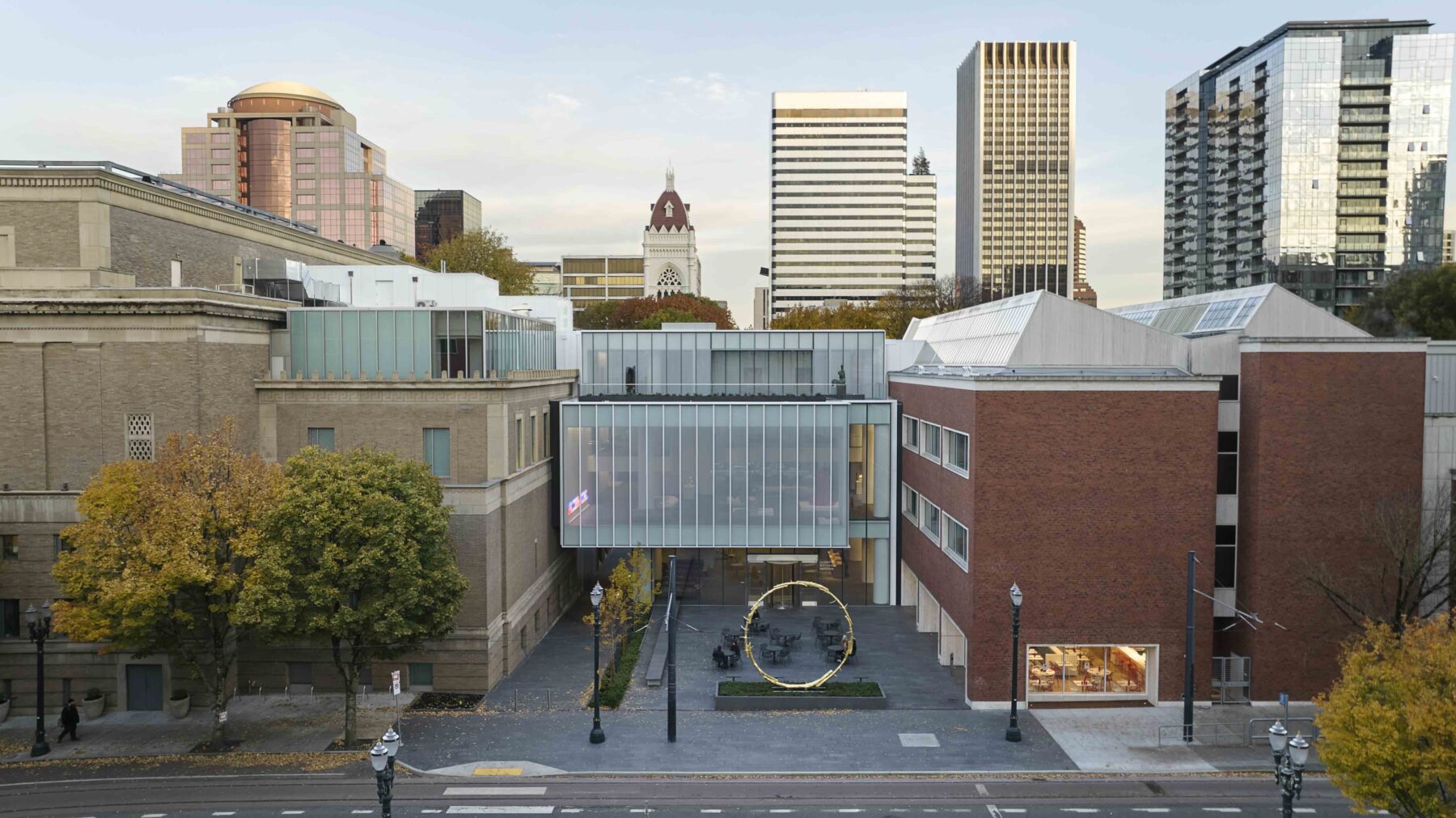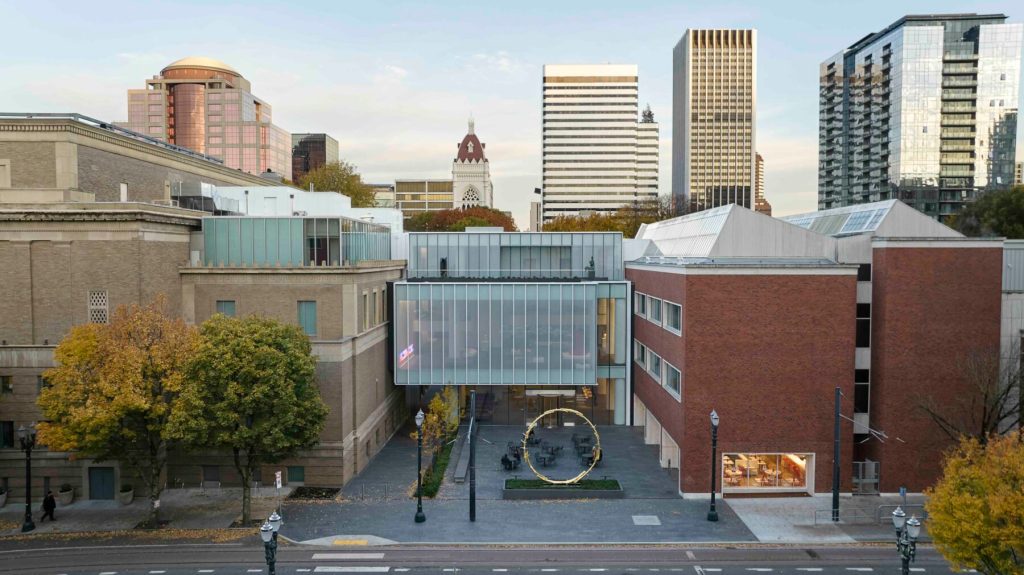 View of the Mark Rothko Pavilion, Tim and Mary Boyle West Plaza at the Portland Art Museum. Featured artwork: the sun by Ugo Rondinone, Photo by Jeremy Bittermann, 2025.
View of the Mark Rothko Pavilion, Tim and Mary Boyle West Plaza at the Portland Art Museum. Featured artwork: the sun by Ugo Rondinone, Photo by Jeremy Bittermann, 2025.
With the opening of the new Rothko Pavilion, the Portland Art Museum takes a huge step forward. The new addition brings the museum’s two principal structures—Pietro Belluschi’s iconic 1932 modernist museum building and the 1924 Masonic Temple now known as PAM’s Mark Building—into a vastly improved, largely satisfying architectural relationship.
The pavilion facilitates dramatic improvements in visitor circulation, new and expanded galleries, and comes with a series of intriguing re-hangs of the museum’s permanent collections. Adding over 100,000 square feet of new or upgraded public and gallery space to the PAM campus, the pavilion connects directly to Mark Building galleries such as the Crumpacker Center, an excellent new space for emerging contemporary art, the museum’s photography galleries, and a range of other modern and contemporary art spaces. The pavilion’s opening also celebrates the unveiling of many of the 300 new art works the museum has acquired in preparation for its launch.
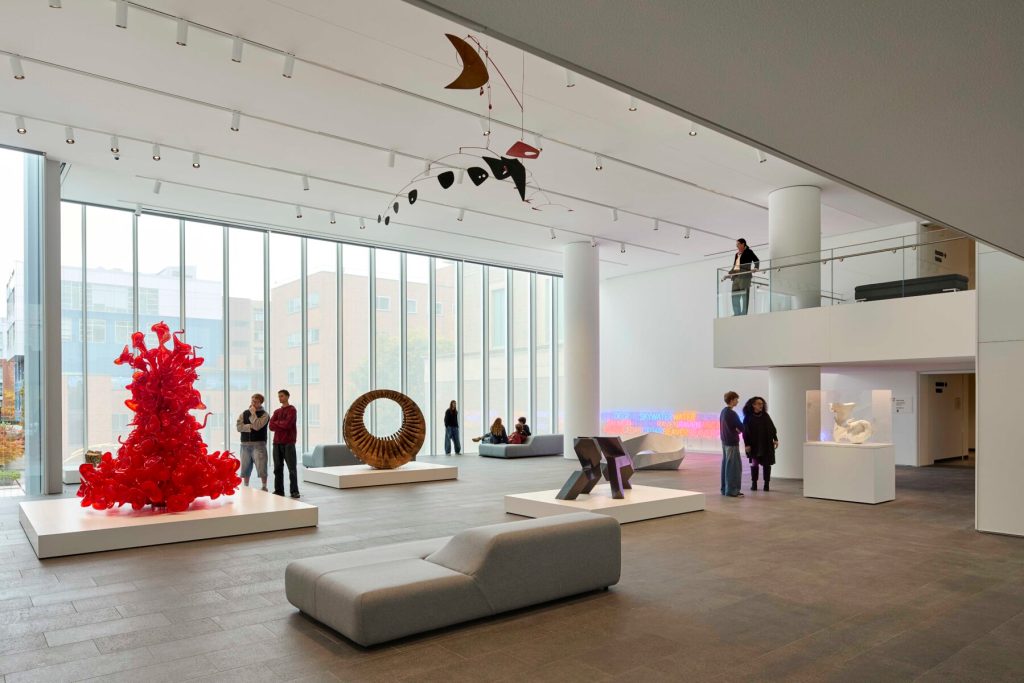 View of the Whitsell Family Gallery in the Mark Rothko Pavilion of the Portland Art Museum, looking Northwest. Photo by Jeremy Bittermann, 2025.
View of the Whitsell Family Gallery in the Mark Rothko Pavilion of the Portland Art Museum, looking Northwest. Photo by Jeremy Bittermann, 2025.
Along with the art and gallery experience, visitors will appreciate new versions of the museum store and the new museum cafe, Coquelico, operated by Providore Fine Foods. There’s also generous, comfortable seating available throughout the galleries.
Funded by a successful $116,000,000 capital campaign and a recently completed $30,000,000 endowment campaign to provide ongoing support of museum operations, the pavilion and accompanying renovations are a perfect capstone to PAM director Brian Ferriso’s 20-year tenure in Portland. They testify to the strong staff he has assembled, his effectiveness as a fundraiser, and the heartening support of the museum’s trustees, members, donor community, and the city of Portland during a time of civic and national upheaval.
When the pandemic hit, I wondered what would happen with PAM’s ambitious plans. But they did it, and I’m impressed.
***
It’s notoriously hard to add to historic museum buildings without messing them up. Take a look at the additions to the Henry Art Gallery at the University of Washington or the Walker Art Center in Minneapolis to see how even good architects can stumble when faced with that challenge. Both institutions gained needed gallery space, but lost the experiential coherence of their historic architecture. It’s even harder to join an iconic museum structure to a comparatively nondescript building that was never intended to have a truly public face.
Sponsor
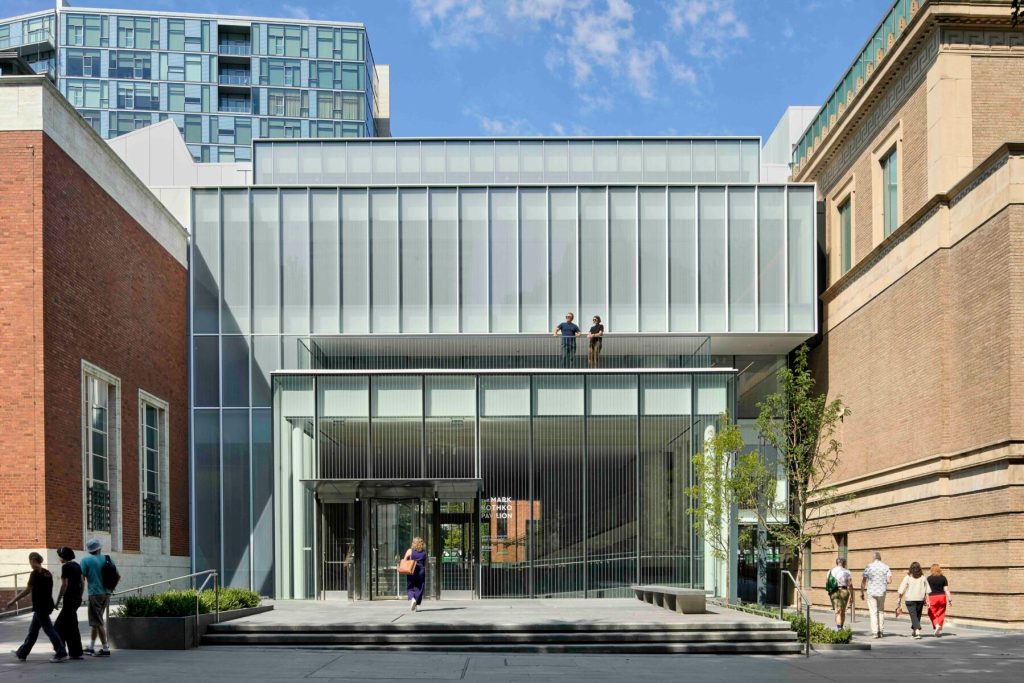 View of the Mark Rothko Pavilion and Brian Ferriso East Plaza at the Portland Art Museum. Photo by Jeremy Bittermann, 2025.
View of the Mark Rothko Pavilion and Brian Ferriso East Plaza at the Portland Art Museum. Photo by Jeremy Bittermann, 2025.
In Portland’s case, the last renovation, overseen by the late John Buchanan during his tenure as PAM’s director, essentially punted on that score. While it provided some good new galleries for Native American and Pacific Northwest art and offered other fixes, PAM’s last addition didn’t really attempt to join its two buildings in any meaningful way. Instead it delivered a set of narrow and ungainly new galleries for modern and contemporary art and photography in the Mark Building. Visitors accessed those galleries via a long, tunnel-like, subterranean corridor. To me, the new spaces barely felt like part of the museum, and its own research demonstrated that few PAM visitors found their way there. Major member receptions and events were held in the ballroom of the former Masonic Temple. It was a splendid party space, but you never really felt like you were “in the museum” when you were there. The result was a set of largely disconnected spaces that didn’t yet serve the museum’s long-term needs.
So when Brian Ferriso arrived in 2006, the museum had a daunting problem to solve: how to finally marry Pietro Belluschi’s beloved and distinguished, architecturally coherent historic original building to the blocky, former Masonic Temple? The challenge extended beyond the marriage as well: was it possible to make the varied components of the museum’s campus feel like the same institution? Could the right architectural intervention offer visitors a more satisfying overall viewing experience? Was it possible to provide for the kind of museum events and celebrations that can help galvanize community support and hence funding? It was a tall order and design challenge.
And as if the questions of architectural style, differing building materials, PAM’s sprawling layout, and visual contrasts weren’t challenging enough, the two structures don’t share identical floor levels or ceiling heights, a profoundly non-trivial design issue. As Ferriso noted in the press walkthrough on November 13th, there are more than ten floor-level changes that needed to be addressed by stairs, ramps, or elevators to create streamlined and accessible visitor pathways across all four floors of the newly integrated PAM campus, one of the renovation’s central goals.
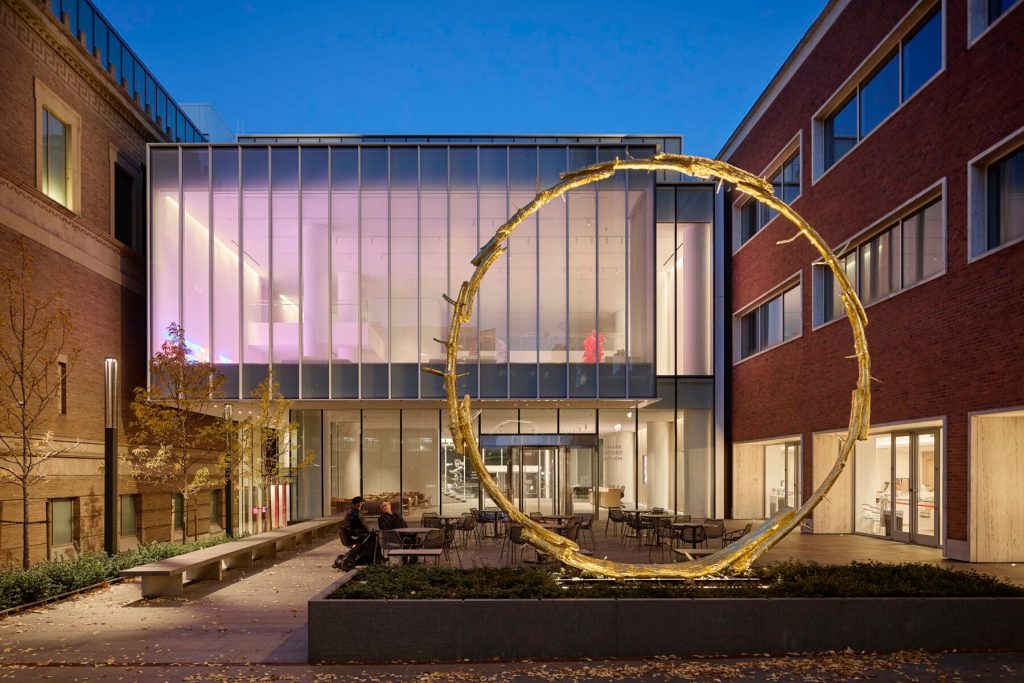 View of the sun by Ugo Rondinone in the Mark Rothko’s Pavilion’s Tim and Mary Boyle West Plaza of the Portland Art Museum. Photo by Jeremy Bittermann, 2025.
View of the sun by Ugo Rondinone in the Mark Rothko’s Pavilion’s Tim and Mary Boyle West Plaza of the Portland Art Museum. Photo by Jeremy Bittermann, 2025.
I am delighted and more than a little relieved to say that on first look, the Rothko Pavilion succeeds brilliantly in achieving the formidable goals of the project. And it does so on many levels both literally and figuratively. Less a building in and of itself than an architectural connector and hinge point, the Rothko Pavilion nevertheless creates a pleasing center and point of arrival. Its alternately transparent and translucent glass walls house what amounts to a complex, semi-see-through architectural block stationed between the two main buildings. The pavilion’s two public-facing facades display a pin-striped minimalism and simple but elegant volumes and geometries. Materially, the fritted glass walls complement the masonry of the Belluschi and Mark buildings. On the ground floor there’s the ticketing area, generous floorspace for arriving groups, visitor queues, and after-hours receptions and events. The museum store and restaurant open directly onto the pavilion. Access to gallery spaces in both buildings is immediate and easy, and a grand staircase leading to the Mark Building finally makes those galleries feel like part of the Portland Art Museum, not an add on and afterthought. The two architectural teams, Vinci Hamp Architects of Chicago and Portland’s Henneberry Eddy Architects are to be congratulated.
Speaking about the museum, Ferriso stresses that PAM is a “campus” rather than a single architectural thing, and that’s true. He also emphasizes that this ambitious renovation was, more than anything else, about people, how they use the museum, and how their experience could be significantly enhanced. Extending the campus metaphor, the Rothko Pavilion functions as a central quad to that campus, a gathering place for people. You could also compare it to a town square, directly connected to all of the cultural, social, and economic functions of its community. Appropriately, the pavilion’s ground floor is dubbed the Swigert Warren Community Commons, acknowledging both the donors who funded the space, and its intended function.
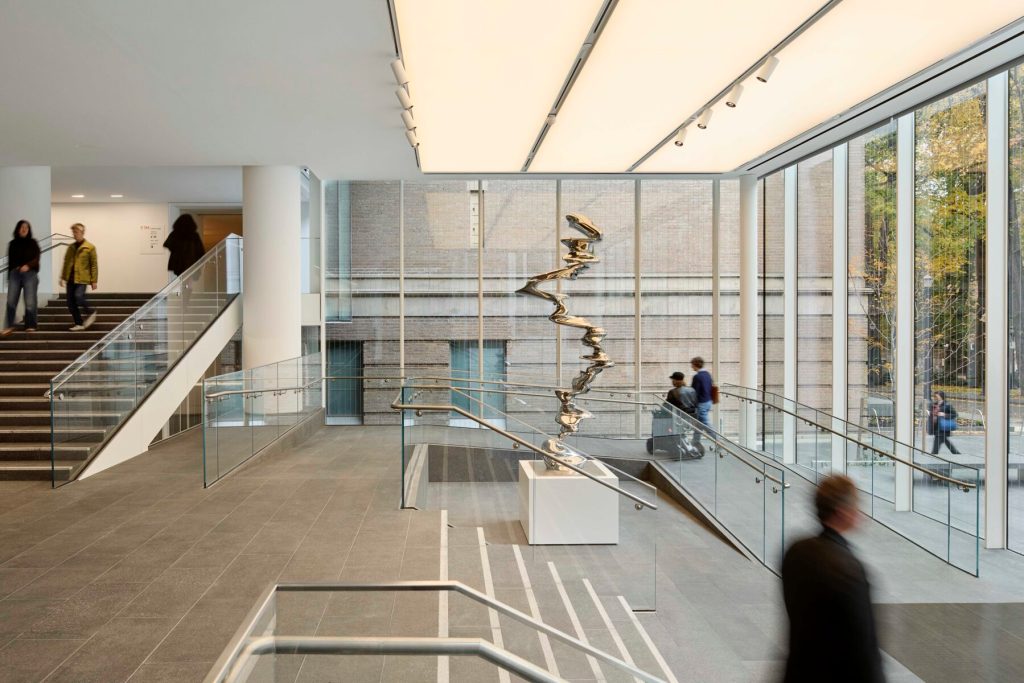 View of the Mark Rothko Pavilion’s Swigert Warren Community Commons entryway at the Portland Art Museum. Photo by Jeremy Bittermann, 2025.
View of the Mark Rothko Pavilion’s Swigert Warren Community Commons entryway at the Portland Art Museum. Photo by Jeremy Bittermann, 2025.
For an excellent in-depth discussion of the Rothko Pavilion’s architectural development, architectural team, and related issues, I’m happy to point to Brian Libby’s ArtsWatch article from October 21. One of the things Libby emphasizes is that the new architecture offers visitors direct links between the Belluschi and Mark Buildings on all four floors. In terms of visitor convenience and circulation, the importance of this cannot be overstated.
Moving easily through the museum, visitors will now be offered views into the museum’s collection galleries for Native American art and Northwest art that were formerly much more challenging to find. Ditto the modern and contemporary art galleries and photography galleries of the Mark Building, including the new Black Art and Experiences Gallery and the new Crumpacker Center. They’ll also have easy access to the Learning Department’s Youth and Community Gallery and hands-on Learning Studio, increasing visibility for PAM’s dynamic and extensive education programming.
Sponsor
In the Rothko Pavilion itself, the large second floor gallery provides generous space for modern and contemporary sculpture, one of the museum’s strengths, and there’s also an outdoor sculpture space on the top floor. Some of the smaller gallery spaces in the pavilion still feel a bit sparsely installed to me, but I know from experience that it takes curators time to learn a new building, and that will be the case here. For now, there’s a number of good pieces on view in these transitional spaces, and the upper levels provide enticing views down into the sculpture gallery and out to the city. Overall, I find the transparency and scale of the Rothko Pavilion quite pleasing.
Throughout all of the new and retooled gallery spaces there’s excellent work on view and exciting new additions to the museum’s collection. I plan to write more about the new permanent collection installations in a coming article after I’ve had more time to look at them carefully, but the fact is, the Portland Art Museum showcases far too much art to take in on a single visit now.
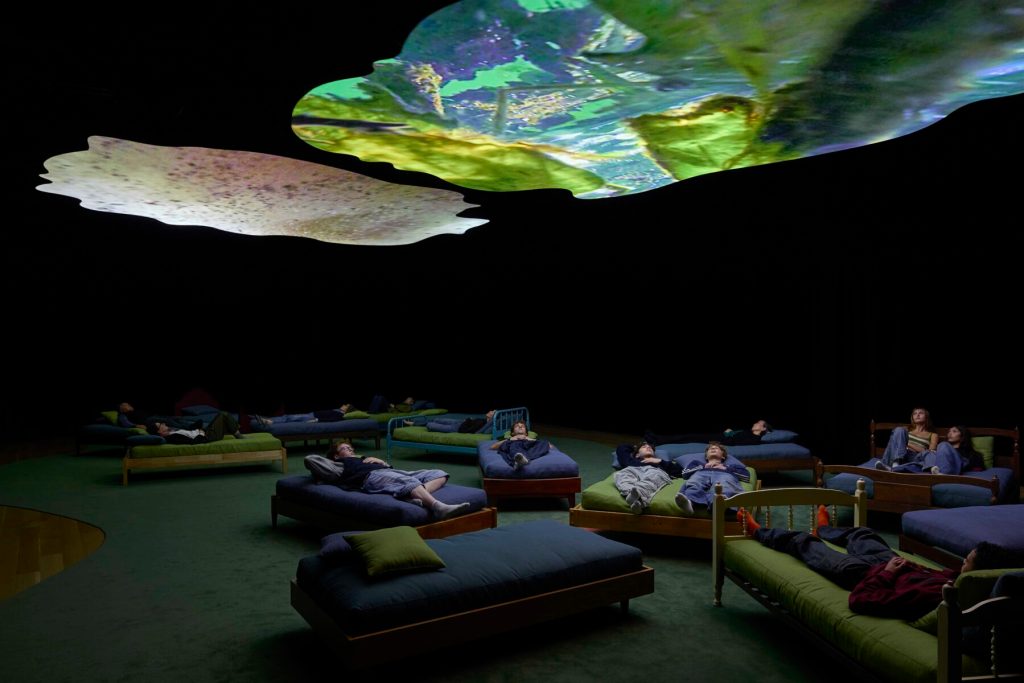 View of 4th Floor to Mildness by Pipilotti Rist in the new Crumpacker Center of the Portland Art Museum. © Pipilotti Rist, Courtesy of the artist, Hauster & Wirth and Luring Augustine/Artists Rights Society (ARS), New York/Pro Litteris, Zurich. Photo by Jeremy Bittermann, 2025
View of 4th Floor to Mildness by Pipilotti Rist in the new Crumpacker Center of the Portland Art Museum. © Pipilotti Rist, Courtesy of the artist, Hauster & Wirth and Luring Augustine/Artists Rights Society (ARS), New York/Pro Litteris, Zurich. Photo by Jeremy Bittermann, 2025
In the meantime, I do want to call out some clear highlights and offer a shoutout to the museum’s Senior Curator of Modern and Contemporary Art, Sara Krajewski, who oversaw the installation of new works throughout the pavilion and in a number of the renovated adjacent galleries. The Crumpacker Center features 4th Floor to Mildness, a beguiling 2018 installation by Swiss video artist Pipilotti Rist, long a mainstay of international biennial exhibitions and museum shows. The video is projected on two amoeba-shaped ceiling screens, and visitors are offered copious seating and laying-down spaces on couches and beds filling the gallery. The video footage itself shows sequences of mesmerizing, dreamy underwater imagery, a favorite of Rist’s, and an accompanying soundtrack. It’s a fun piece. Meanwhile on the lower level, a new 8,000 pixel video wall shows off Heaven’s Gate, an immense single-channel video work by Marco Brambilla, presented by PAM’s Center for an Untold Tomorrows (aka PAM CUT).
There will be a full review on ArtsWatch of Lisa Jarrett’s impressive installation, Tenderhead, that christens the largest space in the new Black Art and Experiences Gallery, so all I’ll say here is that it’s a tour-de-force. If you’ve only seen the smaller works she’s shown at Russo Lee Gallery, or in group shows in PAM, you’re in for a surprise. The two additional spaces in the gallery feature a 2016 video installation by Mickalene Thomas, Do I Look Like a Lady (Comedians and Singers), and From the Collection: Prints by Black Artists, including work by Kara Walker, Alison Saar, Derrick Adams, Robert Pruitt, and more. The gallery will also host a series of performances, movement and sound pieces. It should be noted, too, that the museum’s new acquisition list also includes significant pieces by Fred Wilson—one of his spooky, thought-provoking black mirrors—and Simone Leigh, who is represented by an elegant, tall, golden figure, Sentinel IV (Gold), on view in the Mark Building’s Modern and Contemporary Gallery.
 Installation view of Do I Look Like a Lady? (Comedians and Singers) by Mickalene Thomas in the Portland Art Museum’s Black Art and Experiences Gallery. Photo by Jeremy Bittermann, 2025.
Installation view of Do I Look Like a Lady? (Comedians and Singers) by Mickalene Thomas in the Portland Art Museum’s Black Art and Experiences Gallery. Photo by Jeremy Bittermann, 2025.
The Rothko Pavilion’s grand Whitsell Family Gallery, initially devoted to sculpture, features a double-height space and great natural light from the pavilion’s floor to ceiling windows. For the opening it showcases A Shared Horizon (Western Door), the large neon text piece by Marie Watt that was the centerpiece of her last solo exhibition at PDX Contemporary; an eye-popping red Dale Chihuly; Pedro Reyes’s sinuous Infinity Chair; and more. Visible outside on the patio to the west (10th Street) is Swiss artist Ugo Rondinone’s the sun. Cast in bronze and gilded, it immediately becomes a signature piece for the museum. Huge, round, spindly, golden, and spiky, it’s a somewhat unexpected pick for that task, and perhaps an edgy one. That said, on a gray Portland day in November, it looks fabulous. It’s probably too weird, too big, and too shiny to vanish into the status of a predictable plaza ornament, and I like that.
These works only scratch the surface of what’s on view now at the museum. There’s a candy sampler from Jordan Schnitzer’s impressive and always growing collection (do not miss the trio of pieces by Alison Saar!); an eye-opening retrospective of groundbreaking work by Japanese painter and printmaker Yoshida Chizuko; Rick Bartow: Storyteller, a survey of work by the much-loved and much-missed Oregon artist; and Mary Henry: A Long Unbroken Line, by the Seattle painter. I’m also looking forward to digging into the new installation in the museum’s galleries for art of the Pacific Northwest.
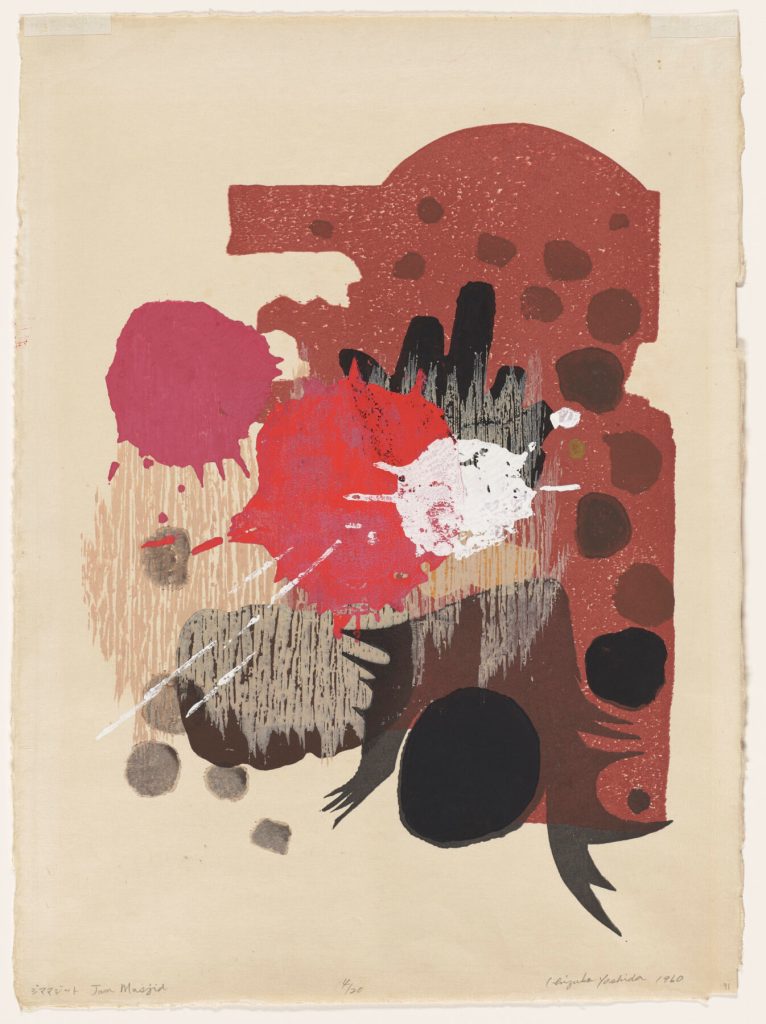 Yoshida Chizuko (Japanese, 1924-2017), Jama Masjid, 1960, color woodblock print on paper, image 18 5/8 in x 13 1/2 in; sheet 22 3/4 in x 16 5/8 in, The Vivian and Gordon Gilkey Graphic Arts Collection. Portland Art Museum.
Yoshida Chizuko (Japanese, 1924-2017), Jama Masjid, 1960, color woodblock print on paper, image 18 5/8 in x 13 1/2 in; sheet 22 3/4 in x 16 5/8 in, The Vivian and Gordon Gilkey Graphic Arts Collection. Portland Art Museum.
Consideration of those will have to wait for a future article, and I should note that I have not touched at all on the permanent collection galleries for American, European, and Asian art, or a wonderful exhibition of Japanese ceramics in the Belluschi building. But before signing off, since it’s called the Rothko Pavilion, I do need to talk about that. Thanks to a twenty-year agreement with the Rothko Foundation and Christopher Rothko, the artist’s son, the museum is showing works by the New York School painter Mark Rothko. Born in Latvia in the former Russian empire, Mark Rothkowitz (his original family name) came with his family to Portland in 1913 as a boy and attended Franklin High School.
Sponsor
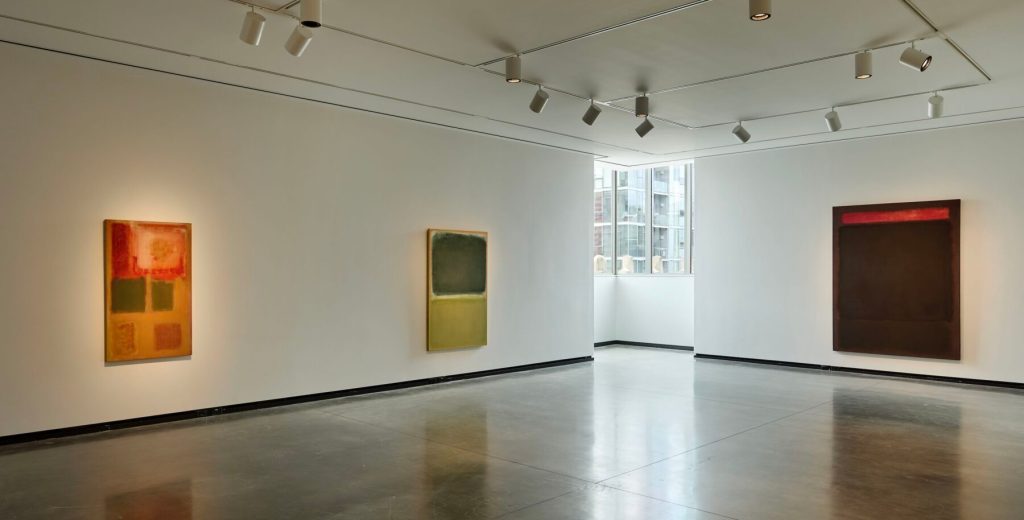 View of The Art of Mark Rothko exhibition and the Portland Art Museum. Photo by Jeremy Bitterman, 2025
View of The Art of Mark Rothko exhibition and the Portland Art Museum. Photo by Jeremy Bitterman, 2025
In honor of that history, the Rothko Foundation will make signature works by him available for the next two decades, and two significant examples of his best work are now on view in the museum, thanks to the foundation. They are shown alongside a small but fascinating selection of early works that trace his artistic evolution from representational figurative painting up to the pre-Ab Ex phase and into the Rothko we know. The location of the Rothko works may seem out of the way since they are installed in a quiet gallery in the southwest corner of the Mark Building. But as Brian Ferriso noted during the press preview, Rothko’s painting is quiet and contemplative, and it begs a quiet space.
I look forward to seeing how the Rothko Pavilion feels when it’s filled with the general public arriving for regular museum visits and moving through its gallery spaces and into those of the Mark and Belluschi buildings. And I want to roam the whole museum more to see how the new circulation plan functions and feels, and how the galleries themselves work in the new layout. Hats off to Brian Ferriso, good luck in Dallas, and well done to the architects, PAM’s staff and their many partners and funders for the hard work it took to bring the Portland Art Museum to a new level. There’s a lot to see!
***
The Portland Art Museum is located at 1219 S.W. Park Ave. in Portland. The museum has special hours and admissions for the Grand Opening. On Thursday, November 20, the museum is open 1 p.m. – 9 p.m. Advance reservations for the grand opening free days are now closed but first-come, first-served free admission is available for walk-up visitors from November 20 through November 23 as capacity allows.
***
Also see Touring the Rothko Pavilion with Brian Ferriso, Brian Libby’s pre-opening story for ArtsWatch.

